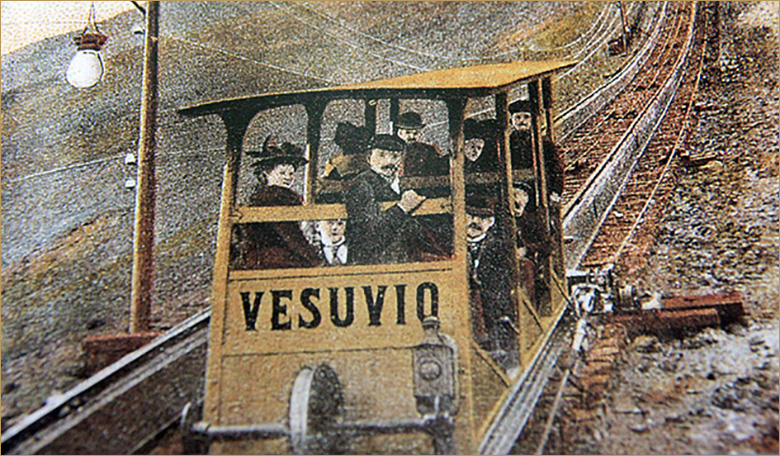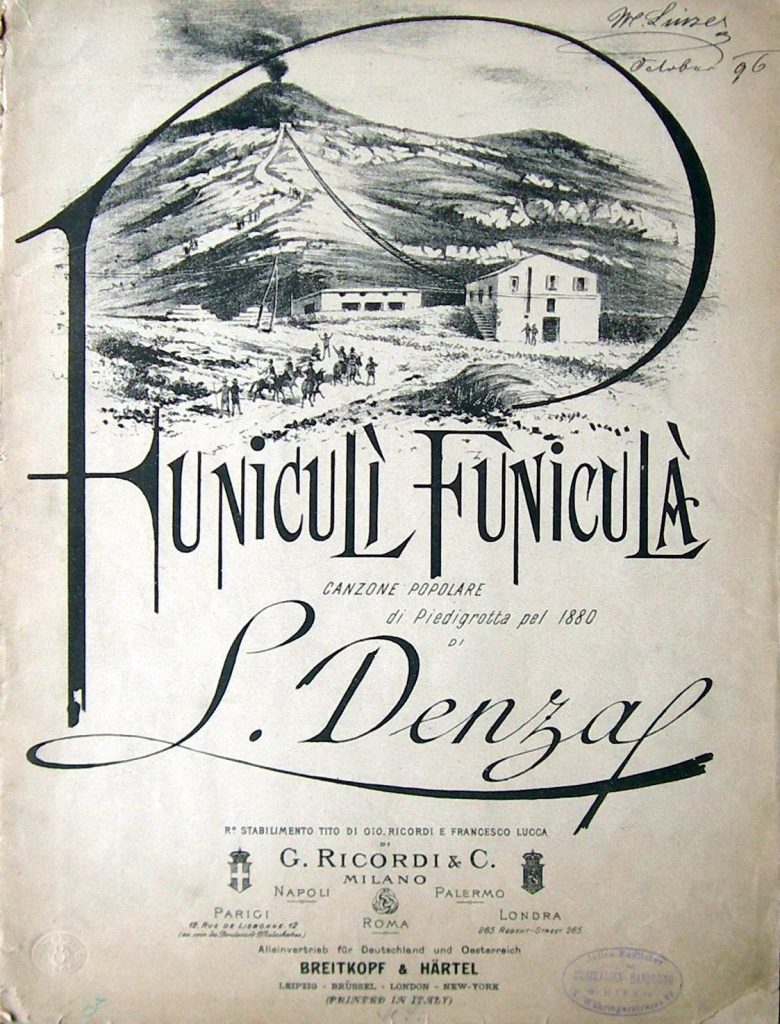THE TRUE STORY OF FUNICULÌ FUNICULÀ
Funiculì funiculà is a classic Neapolitan song, originally created to promote the Vesuvius Funicular, built in 1879 and then inaugurated in 1880.
Funiculì funiculà: the first ‘musical smash’
The Funicular, once inaugurated, was little used by Neapolitans and tourists as, to reach Vesuvius, they preferred traditional and safer means such as donkeys or horses.
The idea was therefore born of promoting the new means of transport through a “secondhand” song: a real musical advertising spot, in order to encourage people to use the funicular.

The text of the piece was composed, however, without a marketing purpose: during a holiday at the thermal baths of Castellammare di Stabia, the journalist Giuseppe Turco composed the text and Luigi Denza was the author of the music.
The song was sung for the first time in the Quisisana Palace of Castellammare di Stabia but became very popular after the “Societè anonyme du chemin de fer funiculaire du Vèsuve” had it presented at the traditional Piedigrotta festival to advertise the cable car.
Funiculì funiculà spread rapidly in Italy and abroad, selling one million copies in the first year of publication by the Italian publishing house Ricordi.
The diffusion of the piece between transpositions and readjustments
In 1886 the Austrian composer Richard Strauss inserted it in the final part of the symphony entitled “From Italy”, inspired by his trip to Italy and including some stops also in Naples and the Amalfi Coast.
The Russian musician Nicolai Rimsky-Korsakov instead transposed the piece in orchestral form, giving it the title of Neapolitan Canto.
At the beginning of 1900 a version in Italian “national” was composed by Denza himself, with a text however characterized by a very free adaptation (Stasera, Nina mia, io son montato, shall I tell you?).

The Turin pianist Alfredo Casella inserted Funiculì Funculà in the finale of the rhapsody Italy, op. 11 and in 1921 Arnold Schoenberg, considered the father of twelve-tone music, arranged it for an instrumental ensemble.
The passage therefore describes to Neapolitans and especially tourists the advantages offered by the new means of transport, which allows you to climb without effort, admiring the view.
The innovation of Funiculì Funiculà and the golden age of the Neapolitan song
The song Funiculì Funiculà is considered by scholars to be the beginning of the golden age of the Neapolitan song, helping to create a new model of song.
In particular, the innovation of replacing the octonary stanzas with a verse clearly distinct from the chorus was very important.
The musicologist Pasquale Scialò then noted how Denza introduced the use of short motifs, to be repeated several times and becoming real musical catchphrases, as well as using an ‘onomatopoeic’ sound with the words ‘Funiculì’ and ‘Funiculà’.
The method proved to be very useful for making the song memorized easily and effectively even today, musical ‘catchphrases’ and tunes have often become a very effective advertising and marketing tool.
The interpretations of Funiculì Funiculà in Italy and in the world
The song was performed by great tenors including, just by way of example, Andrea Bocelli, Mario Lanza, Luciano Pavarotti, Beniamino Gigli, Karel Gott, Muslim Magomaev and many others.
Among the foreign singers who have interpreted or reinterpreted the song: the Gipsy Kings, with the title Que Si, Que No; the Mills Brothers.
The Text of Funiculì Funiculà (in Neapolitan)
Aisséra, oje Nanniné, me ne sagliette,
tu saje addó, tu saje addó
Addó ‘stu core ‘ngrato cchiù dispietto
farme nun pò! (Farme nun pò)
Addó lu fuoco coce, ma se fuje
te lassa sta! (Te lassa sta!)
E nun te corre appriesso, nun te struje
sulo a guardà (sulo a guardà).
Jamme, jamme ‘ncoppa, jamme jà,
Jamme, jamme ‘ncoppa, jamme jà,
funiculì, funiculà!
funiculì, funiculà!
‘ncoppa, jamme jà,
funiculì, funiculà!
Né, jamme da la terra a la montagna!
Nu passo nc’è! Nu passo nc’è!
Se vede Francia, Proceta e la Spagna…
Io veco a tte! Io veco a tte!
Tirato co la fune, ditto ‘nfatto,
‘ncielo se va, ‘ncielo se va.
Se va comm’ ‘a lu viento a l’intrasatto,
guè, saglie, sà!
Jamme, jamme ‘ncoppa, jamme jà,
Jamme, jamme ‘ncoppa, jamme jà,
funiculì, funiculà!
funiculì, funiculà!
‘ncoppa, jamme jà,
funiculì, funiculà!
Se n’è sagliuta, oje né, se n’è sagliuta,
la capa già! (La capa già!)
È gghiuta, po’ è turnata, po’ è venuta,
sta sempe ccà! (Sta sempe ccà!)
La capa vota, vota, attuorno, attuorno,
attuorno a tte! Attuorno a tte!
Stu core canta sempe nel taluorno:
Sposamme, oje né! Sposamme, oje né!
Jamme, jamme ‘ncoppa, jamme jà,
Jamme, jamme ‘ncoppa, jamme jà,
funiculì, funiculà!
funiculì, funiculà!
‘ncoppa, jamme jà,
funiculì, funiculà!
